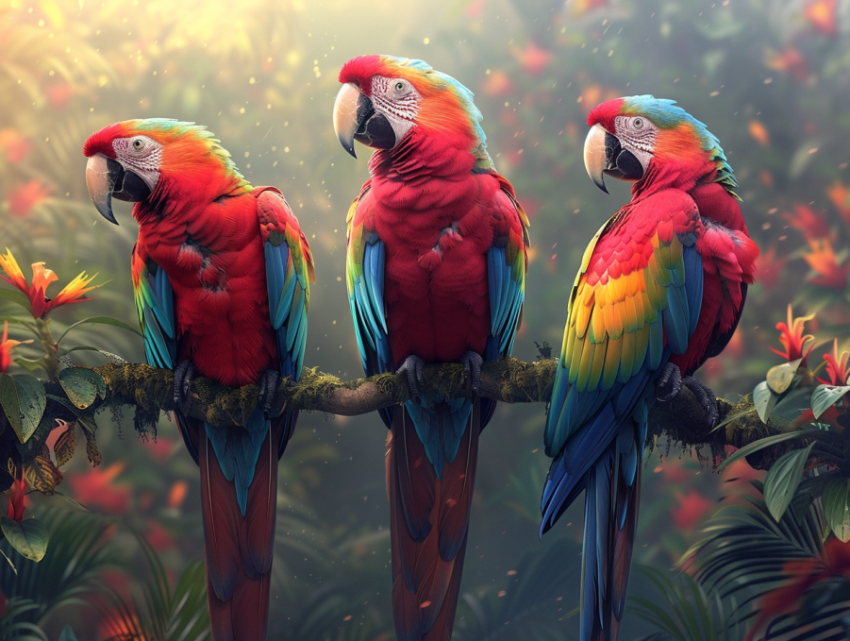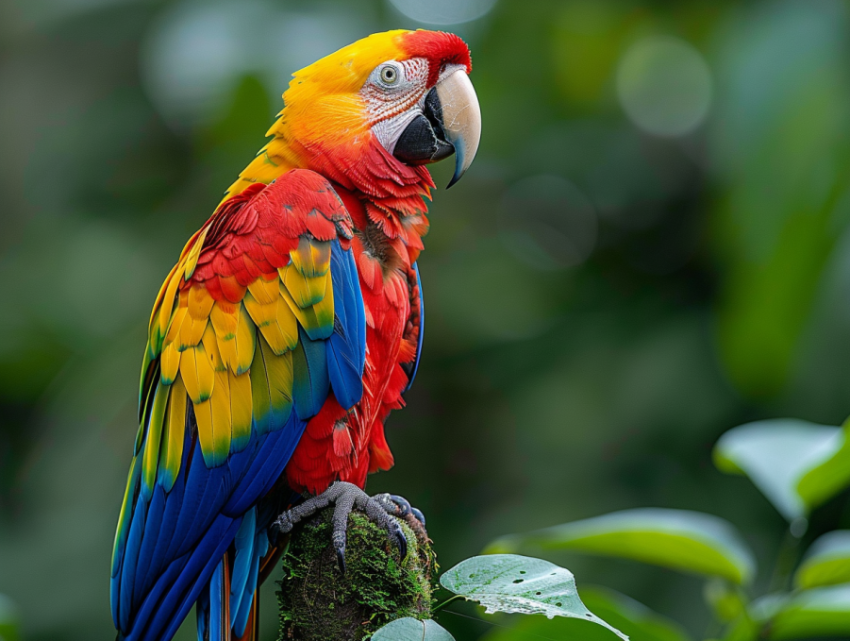



Parrots: Vibrant, Intelligent, and Social Birds
Parrots, with their vibrant colors, remarkable intelligence, and captivating personalities, are among the most popular and well-known birds in the world. These highly social creatures have fascinated humans for centuries, becoming cherished companions and symbols of exotic lands. This comprehensive guide will delve into the captivating world of parrots, exploring their unique physical characteristics, cognitive abilities, diverse species, global distribution, social behaviors, breeding patterns, the challenges they face in the wild, and the responsibilities of keeping them as pets.
What Defines a Parrot?
Parrots belong to the order Psittaciformes, which includes over 400 species. They are characterized by a number of distinctive features:
- Strong, Curved Beak: Parrots have powerful, curved beaks that are adapted for cracking nuts and seeds, as well as for manipulating objects and climbing. The upper mandible is hinged, allowing for a wider range of motion than in most other birds.
- Zygodactyl Feet: Parrots have zygodactyl feet, meaning they have two toes pointing forward and two toes pointing backward. This arrangement provides them with a strong grip for perching, climbing, and manipulating objects.
- Vibrant Plumage: Many parrot species are known for their bright, vibrant plumage, often featuring shades of green, blue, red, yellow, and orange. These colors play a role in species recognition, mate attraction, and camouflage.
- Intelligence and Problem-Solving Abilities: Parrots are renowned for their intelligence. They exhibit advanced cognitive abilities, including problem-solving skills, tool use, and the capacity to learn and mimic sounds, including human speech.
- Social Nature: Most parrot species are highly social, living in flocks that can range in size from a few individuals to thousands of birds.
- Vocalizations: Parrots are highly vocal birds, using a wide range of calls, squawks, whistles, and screams to communicate with each other. Some species are also capable of mimicking sounds, including human speech.
Diverse Parrot Species:
The parrot family is incredibly diverse, with over 400 species exhibiting a wide range of sizes, colors, and adaptations. Some notable parrot groups and species include:
- Macaws: Large, long-tailed parrots native to Central and South America, known for their vibrant plumage and powerful beaks. Examples include the Blue-and-Gold Macaw, Scarlet Macaw, and the critically endangered Hyacinth Macaw.
- Amazons: Medium-sized parrots found in the Americas, typically with predominantly green plumage. Examples include the Yellow-headed Amazon, Blue-fronted Amazon, and the Orange-winged Amazon.
- Cockatoos: Primarily found in Australia, New Guinea, and Indonesia, cockatoos are known for their prominent crests and predominantly white or black plumage. Examples include the Sulphur-crested Cockatoo, Umbrella Cockatoo, and the Palm Cockatoo.
- African Greys: Highly intelligent parrots native to Africa, known for their gray plumage, red tail feathers, and exceptional ability to mimic human speech. There are two main species: the Congo African Grey and the Timneh African Grey.
- Conures: Small to medium-sized parrots found in the Americas, known for their playful personalities and often colorful plumage. Examples include the Sun Conure, Green-cheeked Conure, and the Jenday Conure.
- Parakeets (Budgerigars): Small, long-tailed parrots, with the Budgerigar (often called "budgie" or "parakeet") being the most popular pet bird in the world. Native to Australia, budgies are known for their wide range of color mutations and their ability to mimic sounds.
- Lovebirds: Small, stocky parrots native to Africa, known for their strong pair bonds and affectionate behavior. Examples include the Peach-faced Lovebird, Fischer's Lovebird, and the Black-masked Lovebird.
- Lories and Lorikeets: Specialized nectar-feeding parrots found in Australia, New Guinea, and the Pacific Islands. They have brush-tipped tongues adapted for collecting nectar and pollen. Examples include the Rainbow Lorikeet, and the Dusky Lory.
Global Distribution and Habitats:
Parrots are primarily found in tropical and subtropical regions around the world:
- Neotropics (Central and South America): This region boasts the highest diversity of parrot species, particularly in the Amazon rainforest.
- Australasia (Australia, New Guinea, and surrounding islands): Another major center of parrot diversity, particularly for cockatoos, lorikeets, and rosellas.
- Africa: Home to African Greys, lovebirds, and various Poicephalus species (like the Senegal Parrot).
- Asia: Parrots are also found in parts of South and Southeast Asia, including India, Indonesia, and the Philippines.
Habitats:
Parrots inhabit a variety of environments, including:
- Rainforests: Many parrot species, especially macaws and Amazons, are found in tropical rainforests.
- Dry Forests and Woodlands: Other species, like many cockatoos, inhabit drier forests and woodlands.
- Savannas: Some parrots, such as certain lovebird species, are adapted to savanna environments.
- Mangroves: Certain species, like some lories, are found in coastal mangrove forests.
- Mountains: Some parrots, such as the Kea of New Zealand, inhabit mountainous regions.
- Urban Areas: Some adaptable species, like certain parakeets and cockatoos, have even established populations in urban areas.
Diet and Feeding:
Parrots have diverse diets, but most are primarily herbivorous:
- Seeds and Nuts: Many parrots, especially those with strong beaks like macaws, have diets that consist largely of seeds and nuts. They use their powerful beaks to crack open hard shells.
- Fruits: Fruits are an important part of the diet of many parrot species, providing essential vitamins and sugars.
- Flowers and Nectar: Some parrots, particularly lories and lorikeets, have specialized brush-tipped tongues for feeding on nectar and pollen from flowers.
- Other Plant Matter: Parrots may also consume buds, leaves, and other plant parts.
- Insects: While primarily herbivorous, some parrots may occasionally eat insects, especially during the breeding season when they need extra protein.
Social Behavior and Communication:
Parrots are generally highly social birds:
- Flocking: Most parrot species live in flocks, which can range in size from a few individuals to hundreds or even thousands of birds. Flocking provides protection from predators and facilitates foraging.
- Pair Bonding: Many parrot species form strong, monogamous pair bonds that can last for many years or even for life. These bonds are reinforced through mutual preening, feeding, and vocal communication.
- Complex Communication: Parrots use a variety of vocalizations, body language, and even color changes to communicate with each other. They have complex social structures with established hierarchies.
- Play Behavior: Parrots, especially young birds, engage in play behavior, which helps them develop social skills and learn about their environment.
Breeding and Reproduction:
- Nesting: Most parrots are cavity nesters, using holes in trees or, in some cases, rock crevices or burrows. Some species, like the Monk Parakeet, build communal stick nests.
- Eggs: Parrots lay white, rounded eggs. Clutch size varies by species, ranging from 1 to 10 eggs.
- Incubation: In most parrot species, the female incubates the eggs, while the male provides her with food. Incubation periods range from 17 to 35 days, depending on the species.
- Parental Care: Both parents typically care for the chicks, feeding them regurgitated food.
- Fledging: The time it takes for chicks to fledge (leave the nest) varies by species, ranging from a few weeks to several months for larger parrots like macaws.
Intelligence and Cognition:
Parrots are renowned for their intelligence:
- Problem-Solving: Parrots have demonstrated impressive problem-solving abilities in experimental settings, including using tools to access food and figuring out complex puzzles.
- Mimicry: Many parrot species are capable of mimicking sounds, including human speech. African Greys are particularly well-known for their ability to not only mimic words but also to understand their meaning and use them in context.
- Concept Formation: Some studies suggest that parrots may be capable of understanding abstract concepts, such as same/different, color, shape, and number.
- Tool Use: Some parrot species, like the Palm Cockatoo and the Kea, use tools in the wild, such as sticks to extract food or modify objects.
Conservation Status:
Many parrot species face significant threats in the wild:
- Habitat Loss and Degradation: Deforestation, agriculture, and urbanization are major threats to parrot populations worldwide.
- Illegal Pet Trade: The illegal trapping of parrots for the pet trade is a serious problem, particularly for rare and endangered species.
- Persecution: In some areas, parrots are persecuted as agricultural pests.
- Disease: Introduced diseases can also impact parrot populations.
- Climate Change: Changes in climate can affect food availability and habitat suitability for parrots.
Conservation Efforts:
- Protected Areas: Establishing and maintaining protected areas, such as national parks and reserves, is crucial for conserving parrot habitats.
- Anti-Trafficking Measures: Strengthening laws and enforcement against the illegal pet trade is essential.
- Community-Based Conservation: Involving local communities in conservation efforts can help reduce human-wildlife conflict and promote sustainable practices.
- Captive Breeding and Reintroduction: Captive breeding programs can help bolster populations of endangered species, and reintroduction efforts can help establish new populations in the wild.
- Research and Monitoring: Ongoing research and monitoring are needed to better understand parrot ecology and conservation needs.
Parrots as Pets:
Parrots are popular pets, but they require a significant commitment:
- Long Lifespan: Many parrot species can live for decades, with some larger parrots living 50-80 years or more.
- Social Needs: Parrots are highly social animals and need regular interaction with their owners or other birds.
- Enrichment: Parrots need mental stimulation and enrichment, such as toys, puzzles, and opportunities for foraging, to prevent boredom and behavioral problems.
- Specialized Diet: Parrots require a varied diet that includes not only seeds but also fruits, vegetables, and specially formulated pellets.
- Veterinary Care: Parrots need regular veterinary care from an avian veterinarian.
- Potential for Noise and Mess: Parrots can be noisy and messy, and potential owners should be prepared for this.
Conclusion:
Parrots are extraordinary birds that have captured the human imagination with their beauty, intelligence, and social complexity. They play vital roles in their ecosystems and have become beloved companions for many people. However, they also face significant threats in the wild, and responsible ownership is crucial for those who choose to keep them as pets. By appreciating their unique qualities, supporting conservation efforts, and providing appropriate care for captive birds, we can help ensure that these vibrant and intelligent creatures continue to thrive both in the wild and in our homes. Their continued existence is a testament to the importance of biodiversity and the interconnectedness of life on Earth.
Parrot, Types of Parrots, Parrot Species, Parrot Facts, Parrot Care, Parrot Diet, Parrot Lifespan, Parrot Behavior, Parrot Intelligence, Parrot Talking, Parrot Mimicry, Parrot Training, Parrot Toys, Parrot Food, Parrot Cage, Parrot Health, Parrot Diseases, Macaw, African Grey, Cockatoo, Amazon Parrot, Conure, Parakeet, Budgie, Lovebird, Lorikeet, Parrot Conservation, Endangered Parrots, Pet Parrot, Parrot Pictures, Parrot Videos, Parrot Sounds, Parrot Breeds, Parrot Names, Parrot Lifespan, Parrot as Pets, Parrot Habitat, Parrot Distribution.

